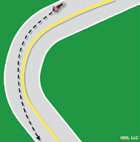
All Locations Closed for New Years Day 2026
All locations are closed Thurs 1 Jan, 2026 for the holiday.
Section 6.2 - 6.3
6.2 – Cornering
Many crash-involved riders enter turns too fast and are unable to complete the curve. The basic turning procedure – slow, look, press, roll – applies to all curves. Every curve is different. Be alert to whether a curve remains constant, gradually widens, gets tighter or involves multiple turns. Ride within your skill level and posted speed limits.
You should move to a position based on road condition and traffic before entering a curve and adjust as necessary. This permits you to spot approaching traffic as soon as possible. You can also adjust for traffic “crowding” the center line or debris blocking part of your lane.
Your best path may not always follow the curve of the road. Change lane position depending on traffic, road conditions and curve of the road.
- If no traffic is present, start at the outside of a curve to increase your line of sight.
- As you turn, move toward the inside of the curve, and as you pass the center, move to the outside to exit.
Widening Curves

Constant Curves
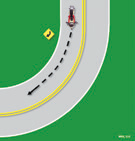
Multiple Curves
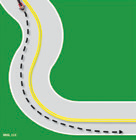
Decreasing Curves (Tighter Turns)
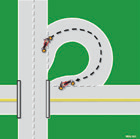
Path Through a Curve

6.3 – Sharing the Road with Commercial Motor Vehicles
Commercial motor vehicles are vital to the economy of Georgia and the United States. Most of the products used in everyday life were delivered to stores by commercial motor vehicles. Drivers of commercial motor vehicles are trained, specially licensed driving professionals. Sharing the road with commercial motor vehicles is a necessary part of travel. Heavy trucks typically weigh 80,000 pounds or more, and riders should use caution when near them.
- A fully loaded tractor-trailer, traveling 55 mph, needs 3 times the distance a car needs to stop.
- Large trucks are more difficult to maneuver, are longer and heavier, and require more room to turn.
- Large trucks have larger blind spots, called “No-Zones.”
- Sharing the road safely includes not remaining in the blind spot of vehicles while passing them.
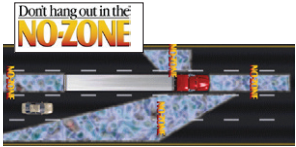
Typically, the larger the vehicle, the larger the blind spots. A commercial motor vehicle’s blind spots are dangerous because truck drivers can’t see vehicles in these areas.
It is impossible to completely avoid a truck’s blind spots. However, car drivers and motorcyclists should not remain in the “No Zone” any longer than needed to safely pass a heavy truck.
The easiest way to avoid lingering in the “No Zone” is to look for the truck driver’s reflection in the side mirror. If you cannot see the driver’s reflection, you are in the truck driver’s blind spot.
As depicted in this illustration, these areas around the truck include: directly in front, directly behind, and along each side of the vehicle - especially on the right side.
In this illustration the commercial motor vehicle’s blind spots, or “No Zones”, are highlighted in blue. These are areas to avoid whenever possible.
High Occupancy Vehicle (HOV) and High Occupancy Toll (HOT) Lanes
Motorcycles are permitted to use HOV lanes regardless of the number of persons riding on the motorcycle. Motorcycles may also use the HOT lanes at no cost by obtaining a toll-exempt PeachPass account. Contact the State Road and Tollway Authority at 1-855-PCHPASS (724-7277). However, motorcycles must pay regular tolls on designated toll roads.
Peach Pass

A PeachPass electronic toll transponder may be obtained to more easily pay for transit on designated toll roads; a PeachPass is required when using HOT lanes. To obtain more information about a Georgia PeachPass for all types of vehicles including motorcycles, go to: http://www.peachpass.com.
The Georgia Tact Project
Targeting Aggressive Cars & Trucks (And Motorcycles!)
Law Enforcement will stop people who drive unsafely around commercial motor vehicles, whether the person is driving a car, motorcycle or commercial motor vehicle.
What to do to avoid getting a citation:
- Don’t cut off commercial motor vehicles. For safety, one car length for every 10 miles per hour of speed is recommended.
- Don’t tailgate. Unlike cars, commercial motor vehicles have big blind spots behind them. Also, car drivers and motorcyclists who tailgate commercial motor vehicles can’t see traffic ahead. If the commercial vehicle brakes suddenly, you have no time to react and no place to go.
- Don’t speed. Speed is a factor in nearly one-third of all fatal crashes.
- Give all commercial motor vehicles plenty of room. Be careful when you or the commercial motor vehicle are entering a highway or merging with traffic.
Test Your Knowledge
- The best way to stop quickly is to:
- Use the front brake only.
- Use the rear brake first.
- Use both brakes at the same time.
- Where should you position your motorcycle when entering a curve:
- The outside of the curve.
- The inside of the curve.
- It depends on road condition and traffic.
Answers
- C – see the section "Stopping Quickly"
- C – see the section "Cornering"